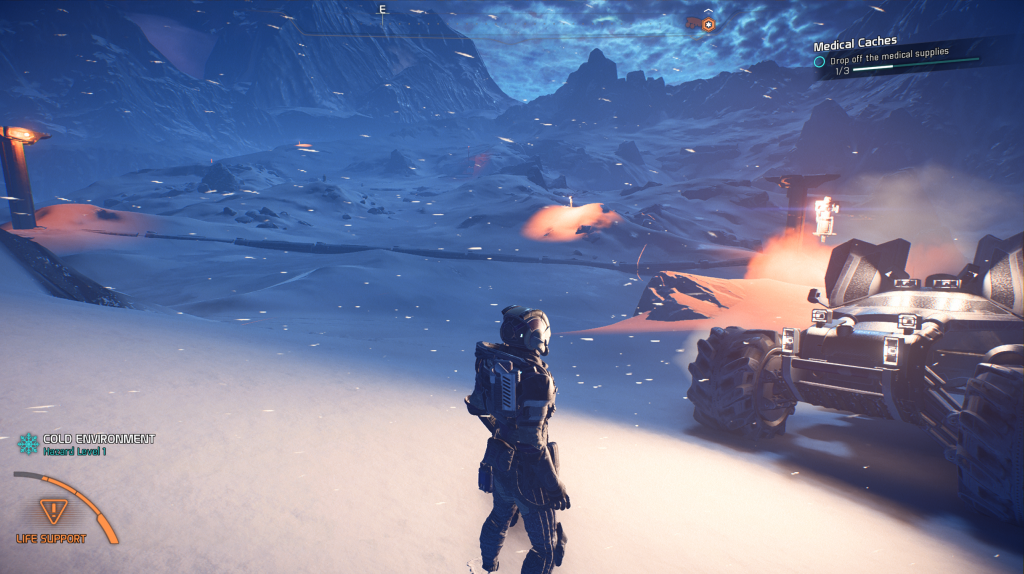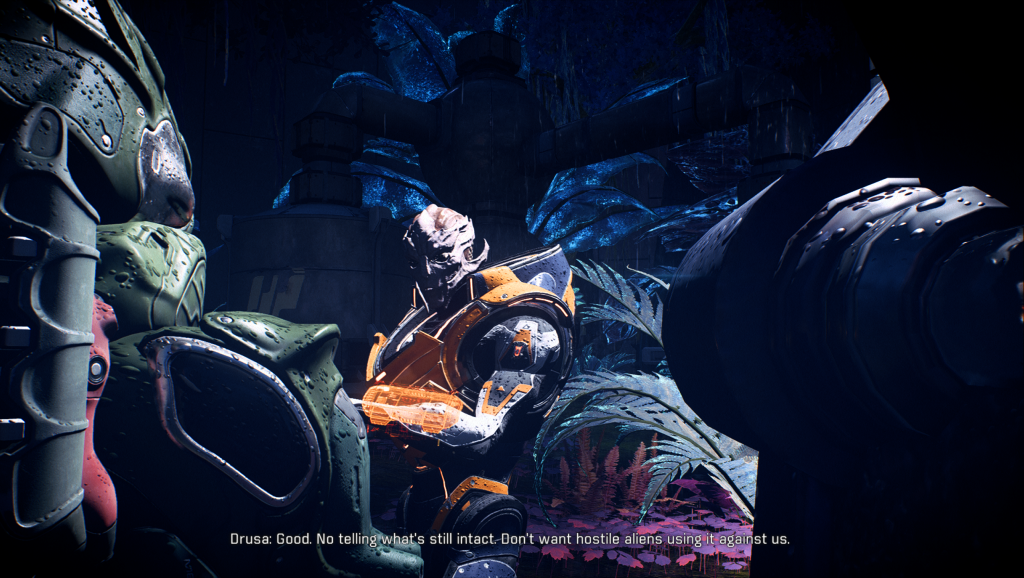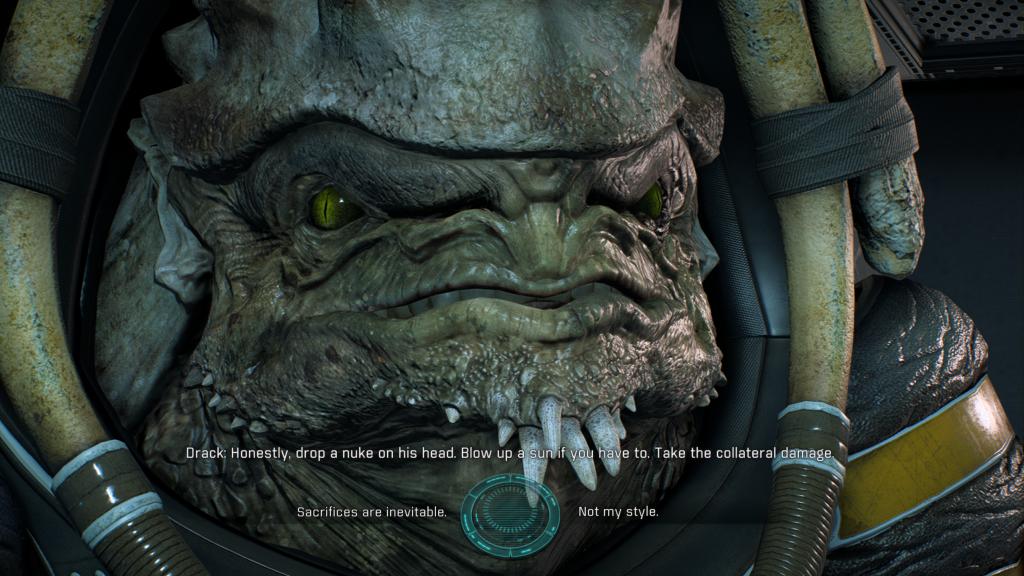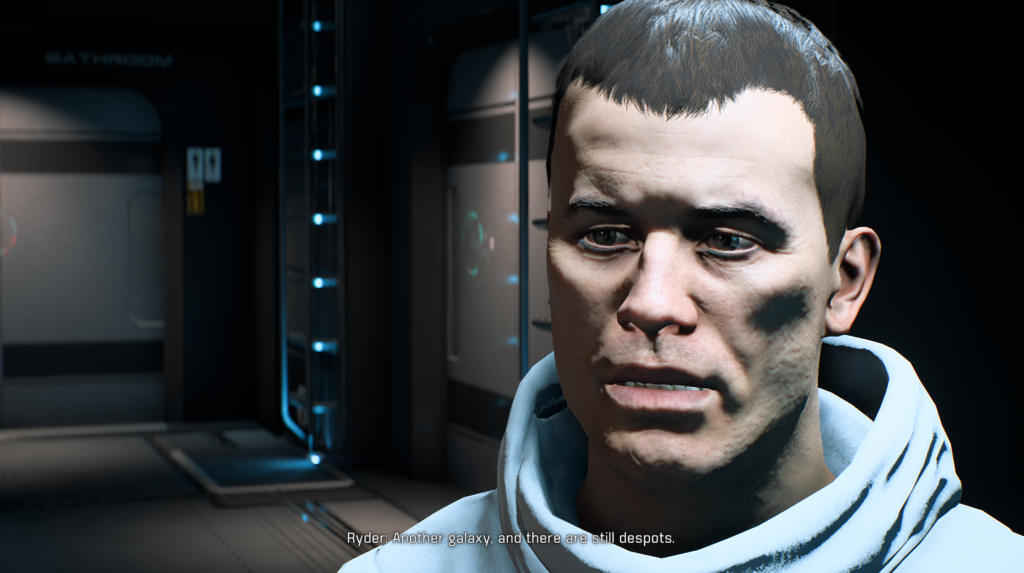It wasn’t supposed to end like this.
Mass Effect: Andromeda was the fourth and, at least for the time being, final entry in the Mass Effect series of games from Bioware. You might have seen them in the news lately; not a lot of good stuff is happening over at Bioware these days. We’ll eventually get around to talking about Dragon Age: Inquisition in this space at one point or another, I suspect, and we can do a real deep dive into the last great game to maybe ever come out of that studio before EA, their own mismanagement, and toxic market incentives led to the disaster that was Anthem and everything that’s happened to Bioware Edmonton and Bioware Austin since. For the time being, all you really need to know is that the guy who they hired away from Blizzard Entertainment to be the live team manager for Anthem after launch is now running both the Anthem Next rebuild to try and make that a professional product, and is in charge of the next product to come out of the Dragon Age IP, title pending. No shade on Christian Dailey; it’s entirely possible he’s genuinely up to the task, and ‘live team manager for your huge GaaS product’ is a position where you put someone you have high hopes for in the future as a project lead. That said, it’s hard to gainsay anyone who took one look at Mass Effect: Andromeda and thought “this studio has some issues to work out,” given everything that’s come after.

But I’m going to do so anyway! Because for all its faults — and it does have some major faults, though perhaps less so than you might have come away believing it did if you only played it during the incredibly-poorly conceived live Beta — I think Mass Effect: Andromeda is not only a good game, but a game that does the Mass Effect IP proud, and a game that is on the whole a better product than Mass Effect 3, especially the version of Mass Effect 3 that players got to experience at launch before various patches and the Citadel DLC fixed up some massive holes in the game. Mass Effect: Andromeda, for reasons ranging from poor launch reception to studio executives eager to get Bioware fully engaged on Anthem’s development, never got that sort of post-launch courtesy. There are massive holes in the game such as “where the Quarians, Hanar, Volus, and everyone else you remember are” that were clearly meant to be filled in by DLC and which never were. It’s a real shame, especially considering how absolutely routine it is by now (well, was, maybe) for Bioware to improve upon its games with substantial post-launch content offerings — this has been the case since Dragon Age: Origins, which had two large new quest areas and a new party member added in DLC for the base game and then was followed up with Dragon Age: Awakening, a wholly-new 20-hour-ish campaign in the DA:O engine that contributed characters and context to Dragon Age 2. That stuff is important, and Mass Effect: Andromeda is substantially lesser for not receiving the same treatment.
The game still stands well on its own, however. The biggest top-level gameplay change between the Mass Effect trilogy and ME:A is that they’ve combined the world-exploration parts and the corridor-shooting main missions into a set of really big open-world zones representing the planets your characters care about. You get your Mako-like rover vehicle, here called the Nomad, and you drive around a huge map filled with assorted challenges, both in the terrain and in combat alike. The overplot of the game has you trying to get these worlds fit for habitation by the colonists from the Milky Way by engaging ancient machines to terraform them into acceptable biomes, which means until you do some of those missions and engage with those quests, standing outside in certain areas drains your life support, and some places on the map just can’t be accessed at all. (There was concern before the game came out, fairly legitimately so, that the plot would be blatantly imperialist in nature as you and all your friends showed up and demanded to run the joint — it turns out they came up with a number of pat, convenient, just-so plot contrivances so that you are in fact assisting the locals in throwing off the yoke of a genocidal, body-horror species of imperialist aliens native to the Andromeda galaxy, who view the star system in which the game takes place as a sort of remote backwater satrap they’ve yet to bring to heel.)

Until the very end of the game, every time you engage in a major plot mission, it is done from one of these big open-world maps — this is a major change from the latter two games in the Mass Effect trilogy, which spent a lot of time making boutique, one-off facility maps for you to rampage through, like the drifting Reaper space hulk in Mass Effect 2 and the biotic school Jack teaches at in Mass Effect 3. The game ME:A most closely resembles, then, is Mass Effect 1, where you were guaranteed at least once per world to engage in a long, arduous (sometimes in a good way, sometimes bad) trek across the surface of each plot world in the Mako rover to chain together these boutique facility levels. In this sense ME:A is a true inheritor of the very first game of the Mass Effect trilogy, rather than manifesting in the intensely on-rails, sometimes visual-novel style that the latter two games in that series found themselves embodying; that’s not necessarily something everybody wanted to go back to.
Encounter-level mechanics are the best they’ve ever been; I feel far more comfortable declaring this by fiat. Whether or not you prefer the on-rails, mission-based nature of Mass Effect 2 and 3 against the roaming spirit of Mass Effect 1 and Andromeda is entirely personal preference, but each game in the quadrilogy has directly and manifestly improved on the combat experience of its predecessors, and Andromeda feels fantastic to play. The biggest improvement to the combat system in this installment is mobility; you have a four-directional jumpjet or biotic dodge and a combat jump, both of which feel better than the combat roll from the previous installments, especially since the dodge gets its own button instead of being bound by default to the run key. Combo skills pick up where Mass Effect 3 left off and have more creative payoffs, cover returns as a more fluid, situational mechanic as the enemy AI is now better about trying to get flanks, but the place where Andromeda really shines is the weapons — Mass Effect 3 got pretty zany with some of its specialty weapons, including bringing back Mass Effect 1 heat clips in a couple places, but since there are three different civilizations for you to be sourcing firearms from (your own, the Heleus cluster natives, and the Remnant civilization that’s running all the spooky terraformers) and you’re not restricted to one weapon of each type but instead a general equipment load, you can have, say, a character build where you take a golf bag full of shotguns into combat: one fires pellets as usual for short range, one fires slugs for alpha-striking at medium to long range, one fires a beam laser that you hold down the trigger on, and one is a grenade launcher. There’s simply a huge range of weapon customization available to you if you’re willing to engage with the game’s research and development (crafting) sub-systems.

Character writing is another space where Andromeda is a flat improvement over previous entries; this claim is likely to be more controversial. It is true that the game never hits the highs of Garrus, Liara, and Tali from the latter two games of the Mass Effect trilogy…but that’s an impossible ask in the first place. You had all of Mass Effect 1 to get familiar with those three characters, and then ME2 and ME3 built on those characterizations to create the iconic fictional relationships you still cherish to this day. What was Garrus in the first game? A cop who snidely wanted permission to do police brutality; an amusing but flimsy loose cannon trope. Liara? A good-girl ingenue who felt like the party’s healer — a characterization so strong and so one-dimensional that it would be played with to excellent effect in the next two games as she became the most powerful organized crime kingpin in the galaxy. Tali was a bit more textured but the Mass Effect 1 Quarians are still a very thinly-veiled, somewhat fraught analogue to the Romani people; it would take Mass Effect 2 and 3 to really flesh them out into something that stood substantially on its own.
The characters of Mass Effect: Andromeda never got that chance and maybe never will, but I’ll put Liam up against the other human soldiers — Vega, Kaiden, Ashley, or heaven forfend, Jacob — any day of the week and take him as the most successfully-realized cast member every time; he has the best loyalty mission not just in Andromeda but the entire Mass Effect franchise. Dreck, the Krogan grandpa who joins your crew, isn’t the most compelling Krogan cast member (that’s still Grunt), but he is the most engaging on a character level; when Ryder’s feeling down, he sends him or her dozens of pictures of guns to make them feel better. Peebee the rogue Asari archaeologist is sort of a second go on the Liara character, except refined through years of Bioware romance writing to be the sort of disaster bisexual that Bioware audiences crave. Cora, the human biotic warrior, is still a straight woman with a short, stylish undercut; this has been a thing in Bioware games for years now — but she’s another interesting look at the outsider nature of human biotics. In her case, she was so powerful they sent her to live with the Asari for a while, and the Asari decided she was too much of a fangirl for them. Vetra is the first female Turian we’ve seen, and might be the thinnest party member in terms of content; she’s got a sister she talks about a lot. Rounding out the crew, Jaal is the companion from the new friendly race in the Heleus cluster, the angara — extremely social super-empaths who look kind of like more expressive, humanoid versions of the aliens from Independence Day. Jaal is a sniper with a lot of somewhat-inadvertent burns for the rest of your crew members. They’re good! Great, if you give them a shot and play through the whole game. Andromeda recognized there’s no reason not to give you access to the characters at all time, at least for conversation content, so basically your entire party is sitting in a Discord group voice chat in your ear, and they’ll chime in as necessary even when they’re not in your party. Also, there’s an internal crew bulletin board on the Tempest that is structured suspiciously like Reddit, and you’ll quickly discover that your party members are quite the shitposters. The voice cast is excellent too, with Natalie Dormer as the fussy, oversharing ship’s doctor Lexi, Kumail Nanjiani as the Salarian administrator in charge of the Andromeda expedition who doesn’t precisely like or trust you, Tann, and Clancy Brown as your shitty, arrogant father who dies in the first twenty minutes.

Where the game admittedly falls down is the plot. At times it feels like either there were too many cooks in the kitchen or no one had a story bible; half the plot revolves around you and your crew being the first aliens from outside the Andromeda galaxy that the angaran people have ever met, while the other half revolves around a bunch of mutineers from the ships of colonists that arrived before you going rogue and starting to set up gunrunning and other criminal enterprises all over the cluster. These two plots don’t really mesh well together. In addition, the big bads, the kett, are both kind of lame and apocalyptically, irredeemably evil; they reverse-engineer other beings into kett, in a kind of clumsier and less scary version of Reaper indoctrination. The upside is, you can’t really get any kett on your crew, or make any peace with them, so they’re just creatures to shoot. And with angara being the only other new species you run into, this brave new galaxy ends up feeling more than a little thin. The main story itself has to do with an ancient species who left behind a bunch of cryptic machines that would terraform the galaxy…and if this is starting to sounds like the Mass Effect trilogy kind of remixed with the Halo franchise, well, one of the cooks in this particular kitchen was the lead writer on Halo 4, and the game’s final setpiece involves you rushing down a forested alien valley in your vehicle as the ground slopes up to meet you. Whereas the characters were a better iteration on what’s come before in the franchise, the plot of Andromeda is an iteration that doesn’t land so well.
And we’d be remiss if we didn’t mention the single biggest thing that turned people off the title the most. It has to be said: Andromeda just never got where it needed to be with its facial aesthetics and animations. Most of the aliens looked great, but the humans resoundingly did not. There are all kinds of reasons for why this is so that don’t need litigating here because at this point, it really doesn’t matter why; the faces and animations just aren’t up to snuff. Most of the game-preset faces can actually get by just fine with just some animation issues, to be fair — the big problem comes when you customize your Ryder. This is a match shot from a conversation with Drack; both characters are in the same room, talking to each other:


It just can’t look like that! It’s something you’ll have to deal with if you want to play through it, and frankly, it doesn’t bother me all that much — but I’m used to games that maybe don’t have the most money put into facial capture and sync (currently playing through 2016’s The Technomancer as well). For a number of people it was a dealbreaker, and it’s hard to fault them too much for it.
Final Verdict
I still love this game, it’s still a great Mass Effect title despite its flaws, and there have been some indications that they might be coming around to doing something with the IP again after the remasters come out. It’s $20 for the standard edition and $30 for the deluxe edition on the Origin store — just spring for the standard — and it’s worth it at those prices. You can also find it in their subscription service; this is the sort of game that gets tossed into bundles everywhere.
Have any questions or feedback? Drop us a note in the comments below or email us at contact@goonhammer.com.


